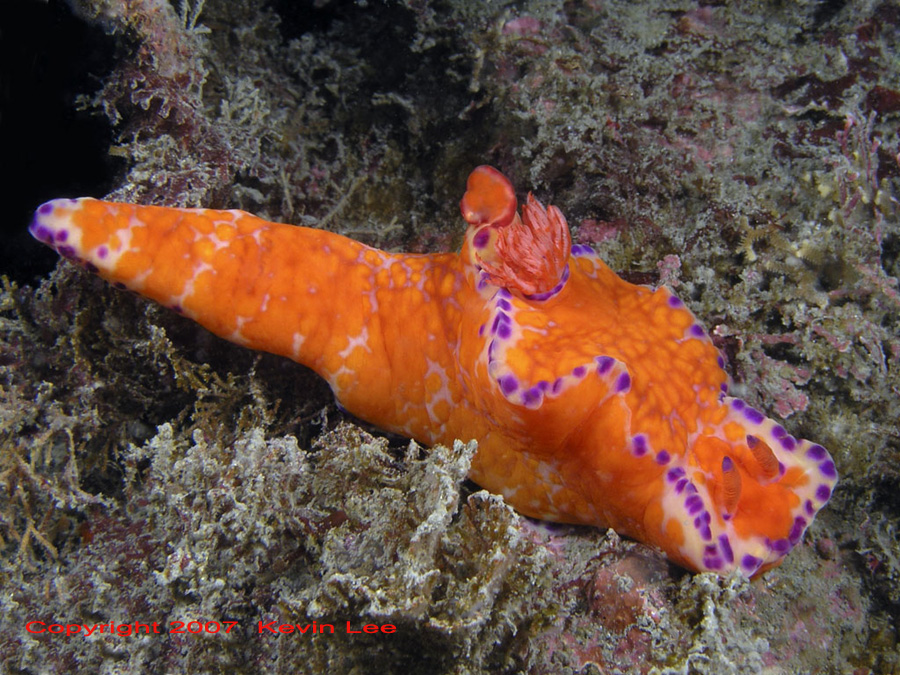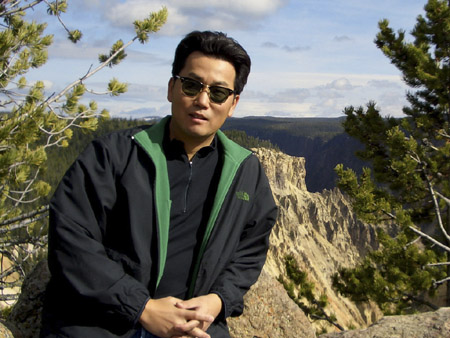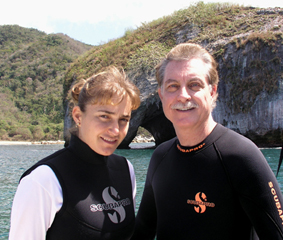 |
Ceratosoma tenue
Photo courtesy of Kevin LeePhoto taken at in waters off South Korea
Ceratosoma tenue Abraham, 1876
Well lucky Kevin had the opportunity to dive the amazing waters of South Korea recently. Wish my employer would send me there. For most of us we can only enjoy the Sea Slugs of this region in Dr. Koh’s beautiful book – Sea Slugs of Korea. Not only did Kevin experience it first hand, but with Dr. Koh.
This weeks fantastic BOW is Ceratosoma tenue , one of the wildest colored dorid nudibranchs out there. A large species, reaching over 180 mm in length, its bright aposematic colors make it easy to ID. Although variable in coloration, the general theme of an orange body with large purple spots along the margin are a giveaway. Ceratosoma tenue can be characterized by the three mantle lobes on each side of the body. There is a large anterior lobe on either side of the head and a large lobe on each side by the gills. Between these two is a smaller, sometimes indistinguishable, lobe.
This species’ aposematic warning is a real one, as the extrabranchial lobe behind the gill possesses a large concentration of acid secreting glands.
This species can be found throughout the tropical Indo-West Pacific.
Hey Kev…. Can I come next time?
Gig Harbor, Washington
April, 2007
Kevin Lee

Kevin Lee thrives on adventure. For three years he backpacked around the world, visiting over 30 countries, including multiple treks to Mt. Everest Base Camp and to the summit of Mt. Kilimanjaro. Among his memorable experiences he fondly recalls a warm hug from Mother Teresa and meeting the Dalai Lama. A few years ago, Kevin learned scuba diving and, in order to share the wonders of the ocean with non-diving friends, he took up underwater photography. Kevin is a director with the Orange County Underwater Photographic Society. His photos have been published in calendars, newspapers, magazines, dive literature and numerous dive related websites. When not diving, Kevin is engaged as a business consultant. Believe it or not, Kevin uses a digital "point-and-shoot" camera, the Olympus C-5060, in a Light & Motion (Tetra) housing, to capture his unique images. He offers this advice: "When shooting macro, I usually have my YS 90-DX strobes pointed at my housing, in order to gently kiss light off the subject, using the outside edge (not inside) of the beam." |
Here is an approach you might consider, my photos are super macro, with black backgrounds (not photo-shopped)... to my eye, the black background is much less distracting, highlights the subject and looks "classy"...
First, I always look for a way to shoot the nudi against open water i.e. nothing in the background that would reflect light back... a combo of the fastest shutter speed (1/800 or shorter) and smallest aperture (F8 or higher) achieves the black background...
Doing this also makes the auto focus much easier, since there's nothing in the background for the camera to mis-focus on... still, i must be careful to watch the focus brackets and see where they lock in... ideally the rhinophores... depth of focus is very sensitive so might have to re-focus multiple times (half shutter, release, etc.)...
Then, position of the strobes is critical... first, I decrease strobe power by 50%... doing so yields better image detail... you know about strobe pattern and principle of lighting with the inside edge of the "cone", correct? i.e. not pointing the strobe directly at the subject, but slightly away from it so that the water (and any particulates in it), between the lens and subject are not lighted, thus minimizing backscatter...
However, in super macro, the distance between the lens and subject is so short, there's hardly any risk of creating backscatter, over this slight distance, even in murky waters... rather, the opposite is true... there's high risk of background backscatter being illuminated... this, instead of using the inside edge of the light cone, use the outside edge... think about it a moment... that means the strobes must actually be pointed at the camera body or side of the lens port... so the outside edge of the light cone kisses the subject...
Give it a try and I think you'll be pleased with the results.
Send Kevin mail at klq77@hotmail.com
March 2005

Ali Hermosillo and Dave Behrens
Author:
Pacific Coast Nudibranchs and Nudibranch Behavior
Send Dave mail at dave@seachallengers.com
|
